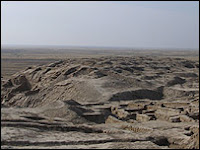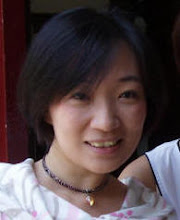By Frances Harrison
BBC News, Isfahan

In the 17th Century the central Iranian city of Isfahan was the capital of Safavid Persia - a place of dazzling wealth, with pleasure palaces, ornate gardens and mosques with the most exquisite tile work.
伊朗中部的城市伊斯法罕在17世紀時曾是波斯薩法維王朝的首都 – 一座由使人心悅的皇宮、裝飾華麗的花園與鑲嵌精美瓷磚工藝的清真寺建構而出的財富之都
The city was a centre to which poets, philosophers and artists flocked from all over the world.
這個城市曾聚集了來自世界各地的詩人、哲學家和藝術家。
Today only a few intrepid tourists make it to Isfahan if they can get a visa.
可是當今就只有取得簽證、勇氣可嘉的遊客到得了伊斯法罕。
And the Naqshe Jahan Square, where the King of Persia once watched polo games, now has traffic running th
rough one end, even though it is a Unesco World Heritage site.
波斯國王曾在此佇足觀賞馬球的 Naqshe Jahan 廣場
[1],儘管被聯合國教科文組織列為世界遺產,廣場的一端還是被車水馬龍的交通所行經。
"It's been destroyed, really, really destroyed; what remains are tiny, tiny pieces of a puzzle. That just gives us a glimpse of the whole," explains journalist Hassan Zuhoori of the Cultural Heritage News Agency in Tehran.
"這裡已經被完完全全的破壞了;剩下的只是微乎其微的幾小塊拼圖罷了。那只夠讓我們模模糊糊的去感覺," 德黑蘭文化遺產通訊社的記者Hassan Zuhoori解釋道。
The "museum city" of Isfahan is rapidly disappearing in the name of modernity and progress.
伊斯法罕這個宛如博物館的城市在現代化及發展的名義下,正快速的消逝中。
"You can't say Isfahan is in danger because we've already passed that point; I don't think there's much left to destroy," says Mr Zuhoori.
"你不能說伊斯法罕這個城市岌岌可危,因為我們已經沒辦法回頭;而且也沒多少東西可以破壞了," Mr Zuhoori說。
Construction boom

Today Isfahan is Iran's second biggest city.
伊斯法罕是當今伊朗的第二大城。
Migration into Isfahan is high and land prices are sky rocketing. Fast profits can be made in construction.
移入伊斯法罕的人數眾多,土地的價格一飛沖天。能迅速獲利的就屬建築業。
Everywhere 400-year-old buildings are being destroyed to make way for new roads or ugly shopping centres.
隨處可見400年屋齡的老房子逃不過被拆毀的命運,被迫騰出空間做為新設的道路或者難看的購物中心。
The local council, which refused to talk to us for this story, has no budget from the central government; it has to make its money from selling construction licences.
拒絕為我們這篇報導做說明的政務委員會,由於沒辦法取得中央政府的預算,只得靠販賣建築執照來補貼這些錢。
On the banks of the Zayandehrud River buildings are not supposed to exceed the tree level but if the construction companies pay a hefty penalty to the local council they can build higher.
在Zayandehrud River河畔的建築物原本不應該超過樹木的高度,然而倘若建商願意支付高額的罰金給政務委員會,他們就能這麼做。
The most well-known example of the city authorities spoiling the skyline of Isfahan is Jahan Nama, a shopping and cultural centre.
由城市當局親自糟蹋伊斯法罕美麗的天際線,這樣的案例中,最著名的就屬Jahan Nama這個購物與文化中心。
So seriously did the construction damage the view from the city's main Naqshe Jahan square that Unesco insisted the top floors be removed.
也正因為這棟建築物將城市最重要的Naqshe Jahan廣場的景觀給破壞殆盡,聯合國教科文組織才不得不堅持最高的幾層樓一定要全部拆除。
Not all have been destroyed. The back part of the building is still too high.
拆除工作也不是很徹底。這棟建築的後半部仍就嫌高了點。
But what many cannot understand is why there was no attempt to build in a more traditional style here.
而眾人所無法理解的是,為何當初在建造時不試著採取較具傳統的風格。

"The municipality doesn't think at all about the problems that worry us," says Dr Parvis Najavand who was culture minister just after the revolution.
"市政當局壓根都沒想過這個問題,這才是令我們真正憂心的事," 在革命後曾擔任文化部長的Parvis Najavand博士說。
He believes Iran's National Heritage Organisation has been so weakened that the municipality no longer listens to what it has to say and it has no power to implement its conservation rules.
他深信伊朗國家遺產組織長久已來一直處於弱勢,根本沒有權力去執行這個遺產保護法,因此市政當局對於他們的發言早就充耳不聞。
Nuclear developmentDr Najavand is also upset that Iran decided to build one of its most important nuclear sites just seven kilometres (four miles) outside Isfahan.
Najavand博士對伊朗政府決定將國家最重要的核電廠設在伊斯法罕城外七公里處同樣憂心忡忡。
"No expert will let you construct a nuclear city so close to a city that is internationally known for its heritage," he says, worrying what will happen to the city's monuments if one day the US launches air strikes on the uranium conversion plant.
"沒有一個專家會同意將核城建在一個以文化遺產揚名國際的城市旁邊," 他一面說一面擔心著萬一哪天美國對鈾轉化場進行空襲時,城市裡有那麼多重要古蹟,後果將不堪設想。
Then there is Isfahan's controversial metro construction.
除此之外,還有伊斯法罕被受爭議的地鐵工程。
"Speed, security and efficiency" is its motto, but the line runs under one of the most historic streets of Isfahan - Chahar Bagh.
"快捷, 安全與效率"是它所標榜的,但是地鐵的路線正巧就是在Chahar Bagh其中一條街道的下方,Chahar Bagh
[2]是伊斯法罕最具歷史意義的街道。
Heritage experts in Isfahan, who were too fearful to speak on camera, told us six train stops are being built under these gardens that date back more than 100 years.
伊斯法罕的文化遺產專家不願意面對鏡頭,但告訴我們有六個地鐵站是建在這幾個超過百年的花園下方。
Already many of the trees have been ripped up.
許多樹木早已被移開。
Once the train tracks run underground, conservationists fear the vibrations from the trains running in both directions will cause irrevocable damage to buildings along the street.
一旦地鐵開始營運,環保人士擔心雙向地鐵列車所產生的震動將對沿街的建築造成無可挽回的損害。
Buildings like the Chaharbagh madrassah - according to some, the most beautiful religious school in Iran.
像Chaharbagh madrassah這樣的建築,對某些人來說是伊朗最美麗的神學院。
The fear is the tile work will literally fall off the walls when it is shaken on a daily basis.
最怕的就是每天產生的震動一定會讓精美的瓷磚工藝從鑲嵌的牆上脫落下來。
And conservation experts say today's craftsmen simply cannot reproduce the same quality and colour of tiles.
古蹟維護的專家認為現今的工匠完全沒辦法再現與過去有著相同品質與色澤的瓷磚。
And when the government is doing it - why should individuals be different?
既然政府都帶頭這樣做了 – 大家又何必唱反調呢?
"Today everyone wants to build... They want to be able to drive their car right up to their house, they want parking spaces, they want to use today's modern facilities," explains Mr Zuhoori.
"現在大家都想建設...誰都想把車子開進家門口、有自己的停車位、使用現在最新的設施, " Mr Zuhoori這樣解釋道。
"They think they need to update their houses to have progress."
"他們認為自己有必要把他們的房子改建好跟上時代。"
'Weak officials' Everywhere old houses are being knocked down and modern apartment blocks are going up in their place.
隨處可見老房子被拆毀,取而代之的是現代化的公寓大樓。

"The main culprit is the government and the national heritage organisation," says Fazlollah Faiz, a local shopkeeper inside the Naqshe Jahan Square.
"政府和國家遺產組織就是整件事的原兇," Naqshe Jahan廣場旁的商店老板Fazlollah Faiz說。
"If an ordinary man has a historic house and wants to knock it down and build a 10-storey building, it's only because he's forced to do that to survive economically," he explains, arguing that the authorities should buy the old houses from their owners so they can build for their children elsewhere.
"如果一個平凡的老百姓把自己一棟有歷史的房子拆掉,建一棟十層樓的大樓,這只會是因為他有經濟上的問題,迫於無耐才這麼做," 他這樣解釋,並且還認為當局應該把老房子從屋主那裡買過來,好讓這些人到別處去為他們的子女蓋房子。
"Unfortunately our officials are weak," Mr Faiz concludes.
"不幸的是我們的官員都很軟弱,” Mr Faiz說著說著就逕自下了結論。
Soon there will be very few of the old Safavid houses left in Isfahan.
很快的,伊斯法罕薩法維式的古老建築將所剩無幾。
All that will remain are the main monuments - the palaces and mosques.
留下來的就只有宮殿和清真寺幾個主要的古蹟了。
But even they are not being well cared for.
然而就連主要的古蹟也沒好好的維護。
Chehel Soton is the pleasure palace of Shah Abbas - its name means 40 columns but in fact there are only 20 - the rest are reflected in the water pool.
Chehel Suton是一座令人喜愛的宮殿,是阿拔斯一世所修建的,它的名字是四十根圓柱的意思,但實際上映入眼簾的就只有二十柱,因為其餘的都在水池的倒影中。
Although there is some restoration of the paintings inside going on, the roof of the veranda shows obvious signs of damp and decay.
雖然針對宮殿彩繪的修復工作是在進行,但是陽臺上方的屋頂卻有明顯受潮朽壞的痕跡。
One Isfahani said he had seen with his own eyes water dripping through the exquisite 400-year-old roof.
一位阿斯法罕人說他還親眼看見水從已有400年歷史的精美屋頂上滴落下來。
There is scaffolding clearly holding up parts of the pavilion in the Ali Qapu palace in the Naqshe Jahan square as well as assisting the work of local contractors who have been brought in for conservation work.
Naqshe Jahan廣場上的Ali Qapu宮殿搭起了棚架,無疑托住了部份的頂篷,同時也好讓當地的承包商進行古蹟修繕工程。
'Rotting wood' Local shopkeepers ask why it has taken so long to get round to preserving the Ali Qapu palace.
只不過是抽個時間來維護Ali Qapu宮殿而已,怎麼要拖拖拉拉這麼久才來做? 當地的商店老板們心裡都有同樣的疑問。

"Actually I have seen for myself that its columns have termites and the wood is rotting," says a man selling souvenirs in the square
在廣場上販賣紀念品的男人說: "我真的親眼看到白蟻在柱子裡爬來爬去,整個木頭都爛掉了,"
"These are monuments that date back hundreds of years; they are an asset for our city."
"這些都是幾百年的古蹟;這可都是我們城裡的資產"
And it is not as if the Islamic buildings are any better cared for than the king's palaces.
就連伊斯蘭的建築也沒能得到比國王的宮殿更妥善的維護。
The Friday Mosque has damp that experts from the National Heritage Organisation told reporters came from a leak in the sewerage system underground.
國家遺產組織的專家告訴記者,星期五清真寺因為地下污水系統產生裂縫而受潮。
While the Imam's Mosque in the Naqshe Jahan Square also has damp, according to local people.
照當地人所說的,Naqshe Jahan廣場上伊瑪目的清真寺也是這樣。
"If they want to destroy it, fine. They should just bring in a bulldozer. But if they want to keep these buildings they should do something immediately," says the souvenir seller.
"如果他們想把它毀了,那也好。他們就乾脆直接把推土機開過來。但是如果他們想要保存這些建築,就應該馬上有所行動," 販售紀念品的小販這樣說。
The 21st Century has not been kind to this city whose glory Iranians say was once equal to half the world.
21世紀並未善待這座城市,它昔日的繁華昌盛被伊朗人比做半個世界
[3]。
And the worry is it is not just Isfahan.
令人擔憂的是這並不單單只發生在伊斯法罕。
"As a person who has spent most of my life trying to preserve Iran's national heritage, training students, writing books and articles, I can say not only in Isfahan but in Iran generally I believe destruction is underway," says Dr Najavand.
"像我這樣窮極一生都在努力保存伊朗的國家遺產、培訓學生、寫書寫文章,我敢說不只是伊斯法罕而是整個伊朗,我想破壞正在進行中," Najavand博士說。
"When facing the Iranian people no generation can be as shameful as ours," he concludes.
"沒有一代會像我們這樣在面對我們的同胞時充滿了愧色," 他斬釘截鐵的說。
Story from BBC NEWS:
http://news.bbc.co.uk/2/hi/middle_east/6251041.stm
Published: 2007/01/12 08:42:25 GMT
© BBC MMVII




.jpg)
 Story from BBC NEWS:
Story from BBC NEWS:



































